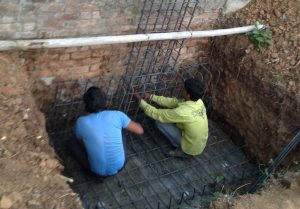What is Eccentric Footing? its 5 Important Points, & Design
The eccentric footing is a spread or wall footing that must resist a moment in addition to the axial column load, and it has the shape of the shoe.
The eccentric footing is designed in such a way that the C.G (centre of gravity) of the superimposed load coincides with the C.G of the base area so, resulting in uniform bearing pressure. This footing is subjected to concentric loading.

Eccentric footing consists of two isolated footings connected with a structural strap, and a one-unit strap connects the foundation. The belt behaves like a connecting beam. When the allowable soil pressure is relatively high, and the distance between the columns is considerable, an eccentric footing is more economical than a combined footing.
This footing has to be done in cases where neighbour’s construction exists, and it is not possible to adopt spread footings. However, when the allowable soil pressure is relatively high and the distance between the columns is significant, an eccentric foundation is more economical than a combined footing.
How to Design Eccentric Footing?
The eccentric footing is designed in such a way that the C.G (centre of gravity) of the superimposed load coincides with the C.G of the base area so, resulting in uniform bearing pressure. This footing is subjected to concentric loading.
It may not be possible to do so in some cases i.e. it will not be possible to spread the footing to both sides of the wall or column if the wall or column under construction is near some other property, as shown in fig;

W1 is a super-imposed load, including the weight of the wall per unit length.
W2 is the weight of the foundation &
W is the resultant load on base.
For the centre of base width B, this resulting load have an eccentricity e, and this eccentric weight is equivalent to;
- A centrally placed load W and
- A Bending moment which is M = W . e
A trapezoidal soil pressure diagram having pressure intensities q1 and q2 will result due to these two;

For the soil, the magnitude of q1 should not exceed the safe bearing pressure, and also, q2 should be positive so that the footing may remain in contact with the ground.
In the extreme case, q2 = 0, when e = B/6, and this gives the maximum value of eccentricity.
The tension will be developed if e is greater than B/6, and the end B of the footing will have loose contact with the soil in that case.
So,

Important Points to Remember:
There are the following important points to remember for eccentric footing as given below;
- To handle the moment and for the floor to act as a double cantilever footing, strange footing requires a strap beam, and if the strap beam is not provided, then due to the eccentricity of the column, the footing cannot handle the moment.
- Eccentric footing requires more depth and heavy steel, and this type of footing is also known as shoe footing. The eccentric foundation is mainly used when space is very little.
- The eccentric footing is primarily used for the property line and avoids tilting the floor in a multi-story building. It needs to connect with another footing, such as a strap beam or combined foundation.
- It is better to plant a column at the edge of the foundation for a multi-story building.
- Always provide a strap beam in footing equal to the length of the foundation.
The Problem of Providing Eccentric Footing:
The major problem is that in some cases, the eccentricities may be so large that there may be part of the foundation where there is no bearing pressure, and for transient conditions, this state may be satisfactory.
We Love Cricket
Eccentric footing design with beam. please solution only one example urgent.
Hi everyone…can we design eccentric footing as isolated footing vt double the axial load ?